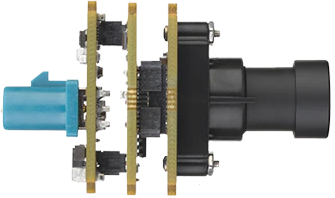I should note this is not how raw video outputs from the image sensor. A 4K image sensor will only has 3840h * 2160v pixels, not 3 channels of such. The 3 channels of color are generated after demosaicing (which can be done by the image signal processor in the computer, in HW3 there is a ISP on the HW3 chip that does it). That means for 4K60p at 10-bit, it only requires 5 Gbps over the coax cable.
Oh, yeah. I forgot that camera vendors claim 4K resolution when they really only have O(8M) subpixels. It's kind of a lie, in that each color channel effectively has only ~720p resolution, but whatever.

In reality the NNs don't need that much resolution from the cameras either (Tesla's current cameras aren't even FHD). Maybe the center camera can have a 4K sensor for digital zoom purposes, but it'll likely be used in a crop mode, and in that mode most image sensors today have readout modes that can output a crop with no additional processing, which means you don't need to send a 4K signal through the wire (just the cropped one).
I would be cautious about saying something that broad. The reason for using higher resolution is to detect moving objects sooner, when they're occupying a smaller area of the sensor. You're not going to want to cycle between a wide-angle view and a bunch of digital crops based on what the computer thinks is interesting, because that would increase your overall latency for detection by a large amount.
Note, Tesla does not use SDI, it uses MIPI CSI-2 (common standard that image sensors use) which is serialized over FPD-Link III (commonly used in automotive industry for backup cameras) which can be transmitted over a single coax cable:
But with the exception of the rear camera, AFAIK, Tesla uses a twisted pair for each camera. If I'm wrong, and they're using coax, then great. But if they have to replace it anyway, fiber is a
lot cheaper than coax. RG-11/U rated for 12 GHz operation (e.g. for 12G-SDI) costs almost $3 per foot. It is also really big stuff, with a four-inch bend radius.
Fiber optic cabling costs about 25 cents per foot, likely with more like a one inch bend radius.
One of these things can easily be routed around a car window. I'll let you guess which.

I imagine for higher resolutions, if they stick with CSI and FPD-Link, they'll just add more cable pairs and it'll still be drastically cheaper than using fiber. MIPI is cognizant of support of 8K or higher resolutions, and has a 18 wire design (6 trios) that delivers 34Gbps which allows for 50MP at 10-bit, which is more than good enough for forseeable applications:
https://www.mipi.org/sites/default/files/MIPI_CSI-2_Specification_Brief.pdf
Have you ever tried to route a bundle of 18 wires? It's hard enough to tightly route an Ethernet cable that contains only 8 wires, and you're talking about more than double that many, not including power. Times four cameras. Somehow that just doesn't seem very practical compared with running one (or even four) optical fibers.
On the cable end if they stick with 4Gbps FPD-Link III, you can squeeze by 10-bit 4K48p (or maybe slightly lower frame rate or res) on a single cable. If you double up the cables/controllers you get 8Gbps, which will give you 10-bit 4K60p. 3 cables gives you 12Gbps, which gets you past 10-bit 6k60p (6144x3160). So on and so forth.
That might be just barely good enough, yes. And that works with the existing twisted pair wiring, assuming the existing wiring is good enough. So it might be possible to do this with just a camera swap. Nice. But if they have to upgrade the wiring, IMO, it makes a lot more sense to switch to fiber than to switch to a bundle of 18 wires that are each just waiting to fail. Remember, the more wires, the more potential points of failure, the harder it is to route the bundle around corners, etc.




